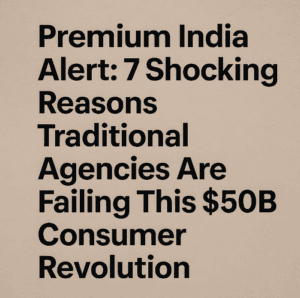Premium India Alert: 7 Shocking Reasons Traditional Agencies Are Failing This $50B Consumer Revolution
India’s consumer market is undergoing a transformative shift as a growing, affluent upper-middle class—65 million strong—redefines premium consumption. No longer driven by basic needs, these consumers seek beauty, self-expression, and autonomy, fueling demand for crafted experiences, from artisanal foods to luxury Indian-made whiskies and heritage-inspired fashion. Traditional advertising agencies, however, risk irrelevance by clinging to outdated “problem-solution” campaigns and performance marketing tactics that prioritize sales over storytelling.
Premium consumers crave emotional resonance, not functional pitches—think desire over utility, identity over conformity. To adapt, agencies must recruit talent fluent in premium lifestyles, elevate design as a core strategy, and blend global aesthetics with India’s cultural richness. Legacy brands and agile D2C startups are already capitalizing on this shift, leaving agencies that fail to innovate speaking a language disconnected from modern aspirations.
The premium wave isn’t niche—it’s a $50 billion opportunity demanding agencies evolve from advertisers to cultural curators. Those who bridge sophistication with soul will thrive; others will fade, overlooked by consumers rewriting India’s consumption story.

Premium India Alert: 7 Shocking Reasons Traditional Agencies Are Failing This $50B Consumer Revolution
India’s consumer landscape is undergoing a seismic transformation. Gone are the days when affordability and functionality dominated purchasing decisions. Today, a confident, globally connected upper-middle class—65 million strong—is reshaping markets with an insatiable appetite for premium, meaningful experiences. From artisanal coffee to luxury skincare, Indian consumers are no longer content with mere utility. They crave beauty, self-expression, and brands that reflect their evolving identities. But as this shift accelerates, a critical question emerges: Are traditional advertising agencies equipped to ride this wave, or are they clinging to outdated strategies?
The Rise of the Premium Indian Consumer
The pandemic crystallized a trend already in motion: India’s upper-middle class emerged financially resilient, digitally savvy, and unapologetically aspirational. Exposure to global aesthetics (via social media and travel) and a renewed pride in Indian heritage have fueled a cultural renaissance. Consumers now seek:
- Beauty as a Lifestyle: Premium isn’t just about price—it’s about craftsmanship, storytelling, and sensory appeal. Think handloom sarees reimagined as luxury fashion or Ayurvedic skincare brands rivaling global giants.
- Fashion as Identity: From gender-fluid clothing to indie designer labels, fashion has become a medium for self-expression, not just conformity.
- Ownership of Destiny: The rise of solopreneurs, creators, and D2C founders reflects a shift from “roti, kapda, makaan” to “beauty, fashion, apni dukaan”—where personal brands signify pride and autonomy.
Even mass-market FMCG players are pivoting, launching premium variants to capture this demand. Yet, while consumers evolve, many agencies remain anchored in old paradigms.
Why Traditional Agencies Are Struggling
Historically, Indian advertising thrived on problem-solution frameworks: “Use this shampoo to avoid dandruff” or “Buy this car for family safety.” These campaigns resonated with a middle-class mindset focused on practicality. But premium consumers aren’t solving problems—they’re chasing desires.
Consider Apple, the world’s most valuable brand. It doesn’t sell specs; it sells belonging to an innovative, creative community. Similarly, Indian single malts like Amrut or Rampur compete with Scotch not through price wars but by evoking heritage and sophistication. Yet, many agencies still default to:
- Functional Messaging: Highlighting features over emotions.
- Performance Marketing: Prioritizing short-term sales over long-term brand love.
- Cultural Blind Spots: Overlooking India’s unique blend of global aspirations and local pride.
The result? Campaigns that feel transactional, not transformational.
Building Brands for the New India: What Agencies Must Do
To win over premium consumers, agencies need a radical reinvention:
1. Hire Talent That “Gets” Premium
Recruit strategists and creatives who’ve lived—not just studied—premium lifestyles. Think globally minded individuals who understand subtle cues, from minimalist packaging to experiential retail. Example: Mumbai-based skincare brand Foxtale disrupted the market by blending clinical efficacy with sleek, Instagram-worthy design—a strategy born from founders deeply embedded in global beauty trends.
2. Elevate Design to a Leadership Role
In a visual-first world, copy alone can’t convey luxury. Designers must lead, not follow. Consider Pipa Bella, a jewelry brand that transformed traditional Indian craftsmanship into contemporary heirlooms through bold, minimalist aesthetics. Agencies need design thinkers who can translate cultural narratives into visual language.
3. Fuse Global Sophistication with Indian Soul
Premium India isn’t about mimicking the West—it’s about redefining luxury on its own terms. Successful brands like Sabyasachi (fashion) and Indri (whisky) marry global quality with Indian storytelling. Agencies must act as cultural curators, blending Mumbai’s hustle with Parisian elegance or Kyoto’s craftsmanship.
4. Create Desire, Not Solutions
Premium brands thrive on emotional resonance. Instead of asking, “What problem does this solve?” ask “What dream does this fulfill?” For instance, yoga brand SARVA positions itself not as fitness but as a gateway to mindfulness—a premium lifestyle choice.
The Cost of Inaction
Agencies clinging to mass-market tactics risk obsolescence. Consumers are voting with their wallets: D2C brands like Mamaearth (premium personal care) and Bombay Shaving Company (grooming) have soared by bypassing traditional playbooks. Meanwhile, legacy brands like Tata Consumer Products are acquiring premium startups (e.g., Organic India) to stay relevant.
The Bottom Line
India’s premium shift isn’t a trend—it’s a $50 billion opportunity (McKinsey, 2024). Agencies must evolve from advertisers to cultural architects. This means:
- Ditching “Volume Over Value”: Premium consumers prioritize quality and exclusivity.
- Investing in Storytelling: Use platforms like Instagram and YouTube to craft immersive narratives.
- Collaborating with Creators: Partner with influencers who embody premium aesthetics authentically.
The future belongs to agencies that can blend the opulence of a Rajasthani palace with the sleekness of a Milan boutique. Those that don’t? They’ll be left narrating stories no one wants to hear.
Insight to Action: For marketers, the lesson is clear—premiumisation demands courage. It’s not about tweaking logos or raising prices. It’s about reimagining brands as symbols of identity, crafting desire through design, and respecting the intelligence of a consumer who seeks more than just a product. The time to act is now—before the wave becomes a tsunami.
You must be logged in to post a comment.